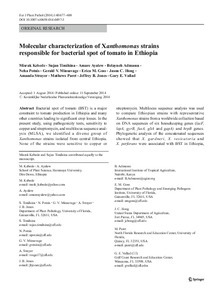| dc.contributor.author | Kebede, M. |
| dc.contributor.author | Timilsina, S. |
| dc.contributor.author | Ayalew, A. |
| dc.contributor.author | Admassu, B. |
| dc.contributor.author | Potnis, N. |
| dc.contributor.author | Minsavage, G.V. |
| dc.contributor.author | Goss, E.M. |
| dc.contributor.author | Hong, J.C. |
| dc.contributor.author | Strayer, A. |
| dc.contributor.author | Paret, M. |
| dc.contributor.author | Jones, J.B. |
| dc.contributor.author | Vallad, G.E. |
| dc.date.accessioned | 2019-12-04T11:03:32Z |
| dc.date.available | 2019-12-04T11:03:32Z |
| dc.date.issued | 2014-08 |
| dc.identifier.citation | Kebede, M., Timilsina, S., Ayalew, A., Admassu, B., Potnis, N., Minsavage, G.V., ... & Vallad, G.E. (2014). Molecular characterization of xanthomonas strains responsible for bacterial spot of tomato in Ethiopia. European Journal of Plant Pathology, 140(4), 677-688. |
| dc.identifier.issn | 0929-1873 |
| dc.identifier.uri | https://hdl.handle.net/20.500.12478/1130 |
| dc.description.abstract | Bacterial spot of tomato (BST) is a major constraint to tomato production in Ethiopia and many other countries leading to significant crop losses. In the present study, using pathogenicity tests, sensitivity to copper and streptomycin, and multilocus sequence analysis (MLSA), we identified a diverse group of Xanthomonas strains isolated from central Ethiopia. None of the strains were sensitive to copper or streptomycin. Multilocus sequence analysis was used to compare Ethiopian strains with representative Xanthomonas strains from a worldwide collection based on DNA sequences of six housekeeping genes (lacF, lepA, gyrB, fusA, gltA and gapA) and hrpB genes.Phylogenetic analysis of the concatenated sequences showed that X. gardneri, X. vesicatoria andX. perforans were associated with BST in Ethiopia, whereas Xanthomonas euvesicatoria was absent from the Ethiopian sample. There was no genetic diversity among the isolated strains belonging to X. gardneri and X. perforans. However, two X. vesicatoria haplotypes were identified indicating at least two different sources of introduction of X. vesicatoria to Ethiopia. All of the X. perforans strains were only pathogenic on tomato and were T3 strains with the exception of one identified as tomato race 4 (T4). The X. gardneri and X. vesicatoria strains were tomato race 2 (T2), but were variable in pepper race determinations indicating variation in effectors among strains. |
| dc.language.iso | en |
| dc.subject | Xanthomonas |
| dc.subject | Tomato |
| dc.title | Molecular characterization of Xanthomonas strains responsible for bacterial spot of tomato in Ethiopia |
| dc.type | Journal Article |
| dc.description.version | Peer Review |
| cg.contributor.affiliation | Haramaya University |
| cg.contributor.affiliation | University of Florida |
| cg.contributor.affiliation | International Institute of Tropical Agriculture |
| cg.contributor.affiliation | United States Department of Agriculture |
| cg.contributor.affiliation | Gulf Coast Research and Education Center, USA |
| cg.coverage.region | Africa South Of Sahara |
| cg.coverage.country | Ethiopia |
| cg.isijournal | ISI Journal |
| cg.authorship.types | CGIAR and developing country institute |
| cg.journal | European Journal of Plant Pathology |
| cg.howpublished | Formally Published |
| cg.accessibilitystatus | Limited Access |
| local.dspaceid | 78128 |
| cg.identifier.doi | https://dx.doi.org/10.1007/s10658-014-0497-3 |

